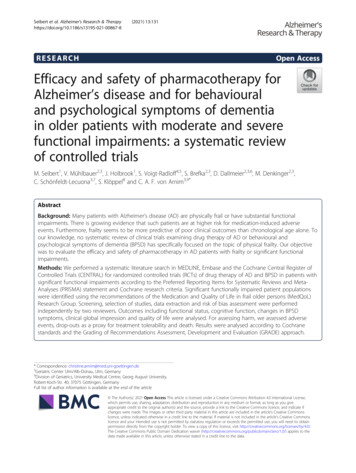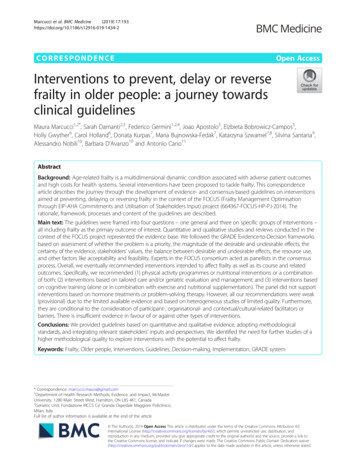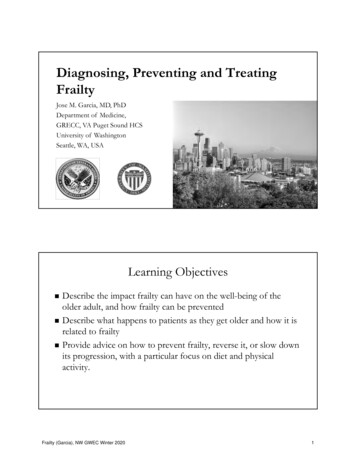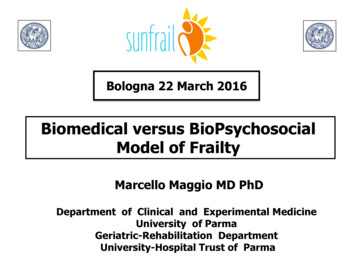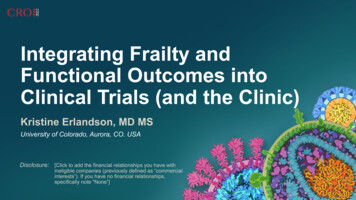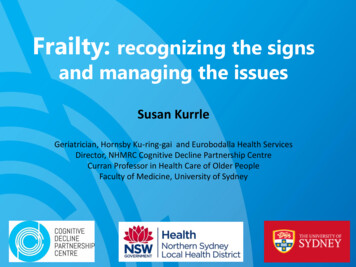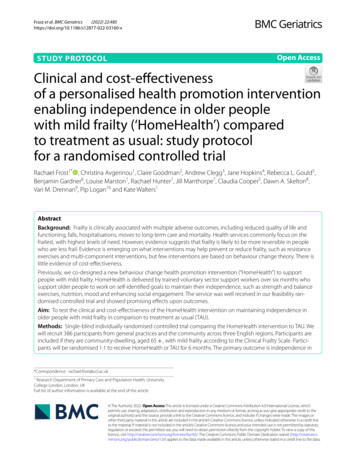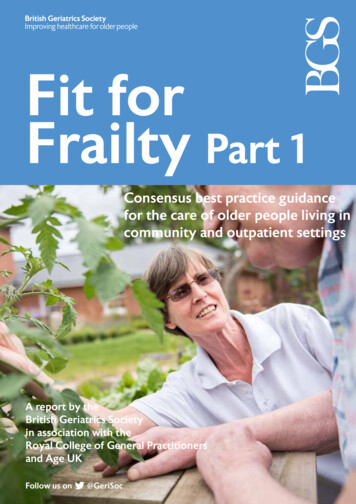
Transcription
Fit forFrailty Part 1Consensus best practice guidancefor the care of older people living incommunity and outpatient settingsA report by theBritish Geriatrics Societyin association with theRoyal College of General Practitionersand Age UKFollow us on@GeriSoc
The British Geriatrics SocietyThe British Geriatrics Society is the professional body of specialists in the health careof older people in the United Kingdom. Membership is drawn from doctors, nurses,allied health professionals, scientists and others with a particular interest in the careof older people and the promotion of better health in old age. It has 3,000 membersworldwide and is the only society in the UK which draws together experts from all therelevant disciplines in the field.The BGS uses the expertise of its members to inform and influence the developmentof health care policy in the UK and to ensure the design, commissioning and deliveryof age appropriate health services. The BGS works closely with other specialist medicalsocieties and allies itself with age-related charities.The BGS strives to promote better understanding of the health care needs of olderpeople. It shares examples of best practice to ensure that older people are treated withdignity and respect and that wherever possible, older people live healthy, independentlives.Citation for this document: Fit for Frailty - consensus best practice guidance for thecare of older people living in community and outpatient settings - a report from theBritish Geriatrics Society 2014Fit for frailty consensus best practice guidance for the care ofolder people living in community and outpatient settingsThis guidance is intended to support health and social care professionals in thecommunity, in outpatient clinics, in community hospitals and other intermediate caresettings and in older people’s own homes. Guidance for professionals encounteringolder people with frailty in acute hospitals has been published in the Silver Book 1 andwork to develop a checklist to support the management of older people with frailty inacute hospital settings is ongoing 2 under the auspices of the FRAILsafe programme.It was produced by the British Geriatrics Society in association with Age UK and theRoyal College of General Practitioners.CopyrightAll rights reserved. No part of this publication may be reproduced in any form(including photocopying or storing it in any medium by electronic means and whetheror not transiently or incidentally to some other use of this publication) without thewritten permission of the copyright owner. Applications for the copyright owner’swritten permission to reproduce any part of this publication should be addressed to thepublisher.Copyright British Geriatrics Society 2014Rebranded edition 2017British Geriatrics SocietyMarjory Warren House31 St John’s SquareLONDON EC1M 4DNISBN No. 978-0-9929663-1-72
ContentsList of recommendations . 5Foreword .4What is frailty? .Background, causes and prevention of frailty .66Recognising and identifying frailty in individuals .7Why do we need to identify frailty? .7In what circumstances does it help to understand that the patient has frailty? .7How can we recognise frailty in an individual? .7Frailty syndromes in an acute/emergency situation .Recognising frailty in a more routine situation .78Is there any value in looking for frailty on a population or practice basis? .9Managing frailty .Comprehensive geriatric assessment .Providing better care for an individual with frailty .Holistic Medical Review, including diagnosis of underlying illness, medicinesreview and assessment of capacity .Individualised care and support plans .Assessment and management in urgent/emergency situations .The management of older people with frailty in the outpatient surgical setting .Managing the physical aspects of frailty - what is the evidence that frailtycan be reversed and what interventions are effective? .91011Conclusion .14References .15Appendices .16Project Working Group .4Copyright .211121313143
ForewordFit for Frailty projectIn the jargon she was “FLOF” (or “Found lying on theFloor”). That is to say the home care staff had found MrsGreenaway lying on the floor next to her bed at 8 a.m.on a Saturday morning. “It was a fall waiting to happen,”they said. A couple of telephone calls later and MrsGreenaway found herself under the unforgiving lights ofthe local Accident and Emergency (A&E) department.No injuries or notable illnesses detected but the A&E stafffelt insecure in their clinical decision making: a paucityof background medical details; uncertain even of currentmedication or allergy status. And the A&E department wasas busy as always. Easiest by far to admit and sort things outdownstream on a ward. Not at all what Mrs Greenaway wasexpecting.The Fit for Frailty guideline was born out of workshopmeetings held by the offices of the British Geriatrics Societyand AGE UK in London.Mrs Greenaway has frailty and is a single story but of moregeneral concern. Over 640,000 older people present toA&E departments each year after a fall. Serious injuriesand illness are fortunately uncommon. In some wayseverything was done just as might have been expected. Shewas given timely, safe, efficient care - the emergency caresystem at its best. But the outcome - admission to hospital- seems disproportionate to the predicament. Might a morecommunity based approach have been possible? Perhapsa home based assessment by a Crisis Response Team? Ormore robust proactive and preventative care that targetedthe modifiable components of frailty before the health crisisoccurred?Professor Avan Aihie Sayer - MRC Clinical Scientistand Professor of Geriatric Medicine, University ofSouthampton;Dr Eileen Burns - Clinical Director Older People, St JamesHospital, LeedsProfessor Tom Dening - Barchester and NottinghamshireHealthcare and Professor in Dementia Research, Institute ofMental HealthMr Tom Gentry - Age UKDr John Hindle - Consultant Geriatrician Clinical SeniorLecturer Bangor University and Llandudno Hospital, WalesProfessor Steve Iliffe - Professor of Primary Care for OlderPeople at University College LondonProfessor Finbarr Martin - Consultant Geriatrician, Guy’s& St Thomas’ NHS Foundation TrustDr Christine McAlpine - Clinical Lead for Stroke for NHSGlasgow and ClydeDr Caroline Nicholson - Post Doctoral Research FellowKings College LondonDr Cathy Patterson - Consultant Geriatrician RoyalVictoria Hospital, BelfastDr Joanna Preston - Trainee representative, Clinical QualitySteering Group, British Geriatrics SocietyProfessor John Young - National Clinical Director ofIntegration and Frail and Elderly CareThese possible alternative responses are successful realities insome areas in the UK but they are far from widespread. Andtherein lies our challenge: to take what is a reality in someplaces and to make it routine throughout the NHS. In part,this will require new capacity and resilience within primary,community and social care, not forgetting the essentialrole of the housing and voluntary sectors. But there is alsoan important need for the workforce to be appropriatelyskilled to meet the needs of older people who have frailty,and for the appropriate organisational systems and processesto be in place. These aspects are addressed fully withinthis important report developed by the British GeriatricsSociety in association with Age UK and the Royal Collegeof General Practitioners. The core principle of distinguishingpeople who have frailty from fit and well older people isplaced centre stage, followed by practical guidance on howhigh quality and safe community care can be provided.Follow up guidance is planned shortly aimed specificallyat commissioners to encourage a robust community-basedresponse to older people who have frailty.John YoungNational Clinical Director for Integration & Frail Elderly,NHS EnglandHonorary Consultant Geriatrician, Bradford TeachingHospitals NHS Foundation TrustHead, Academic Unit of Elderly Care and Rehabilitation,University of Leeds4The Project Lead and lead author of the guideline was DrGill Turner, Vice President for Clinical Quality, BritishGeriatrics Society.Dr Andrew Clegg, Clinical Senior Lecturer, Leeds Instituteof Health Sciences and Dr Jane Youde, ConsultantGeriatrician, Nottingham were also active in authoringseveral sections of the guidance.Other members of the workshop included:Acknowledgements:We would like to extend our thanks to Dr Jugdeep Dhesiand Dr Judith Partridge from the Proactive Care of OlderPeople undergoing Surgery (POPS) service, St Thomas andGuys Hospital London, for their valuable insights, Ms ReciaAtkins, Production Editor of this publication, and MrsJoanna Gough for her administrative support.
Full list of BGS recommendations for the recognition and management offrailty in community and outpatient settings Older people should be assessed for the presence of frailty during all encounters with health andsocial care professionals. Gait speed, the timed-up-and-go test and the PRISMA questionnaire arerecommended assessments.Provide training in frailty recognition to all health and social care staff.Do not offer routine population screening for frailty.Look for a cause if an older person with frailty shows decline in their function.Carry out a comprehensive review of medical, functional, psychological and social needs based on theprinciples of comprehensive geriatric assessment.Ensure that reversible medical conditions are considered and addressed.Consider referral to geriatric medicine where frailty is associated with significant complexity,diagnostic uncertainty or challenging symptom control.Consider referral to old age psychiatry for those people with frailty and complex co-existingpsychiatric problems, including challenging behaviour in dementia.Conduct evidence-based medication reviews for older people with frailty (e.g. STOPP STARTcriteria).Use clinical judgment and personalised goals when deciding how to apply disease-based clinicalguidelines to the management of older people with frailty.Generate a personalised shared care and support plan (CSP) outlining treatment goals, managementplans and plans for urgent care. In some cases it may be appropriate to include an end of life careplan.Where an older person has been identified as having frailty, establish systems to share health recordinformation (including the CSP) between primary care, emergency services, secondary care andsocial services.Develop local protocols and pathways of care for older people with frailty, taking into accountthe common acute presentations of falls, delirium and sudden immobility. Wherever the patientis managed, there must be adequate diagnostic facilities to determine the cause of the change infunction. Ensure that the pathways build in a timely response to urgent need.Recognise that many older people with frailty in crisis will manage better in the home environmentbut only with appropriate support systems.5
IntroductionThis guidance is intended to support health and social careprofessionals in the community, in outpatient clinics, incommunity hospitals and other intermediate care settingsand in older people’s own homes. Guidance for professionalsencountering older people with frailty in acute hospitalshas been published in the Silver Book1 and work to developchecklist to support the management of older people withfrailty in acute hospital settings is ongoing.21. What is frailty?Frailty is a distinctive health state related to the ageingprocess in which multiple body systems gradually lose theirin-built reserves. Around 10% of people aged over 65 yearshave frailty, rising to between a quarter and a half of thoseaged over 85 years.3Older people living with frailty are at risk of adverseoutcomes such as dramatic changes in their physicaland mental wellbeing after an apparently minor eventwhich challenges their health, such as an infection or newmedication. The purpose of this guidance is to advise aboutaction which can be taken to prevent these adverse outcomesand help people live as well as possible with frailty.It is important to understand the difference between frailty,long term conditions and disability. Many people withmultiple long term conditions (so called multi-morbidity)will also have frailty which may be masked when the focusis on other disease based long term conditions. Likewise,some people whose only long term condition is frailty maybe low consumers of health care resources and not regularlyknown to their GP (until they become bed bound, immobileor delirious as a result of an apparently minor illness). Theremay be overlap between the management approaches forpeople with multi-morbidity and those with frailty butthese conditions are not identical and this guidance looksprimarily at frailty. Similarly, there is overlap between frailtyand physical disability – many people with frailty also havedisability, but lots of people with a long term disability donot have frailty. Frailty may be the cause of disability insome patients and the consequence in others.The language and management of frailty can act as barriersto engaging with older people who may not perceivethemselves, or wish to be defined, by a term that is oftenassociated with increased vulnerability and dependency.Older persons may not recognise themselves as living withfrailty and there is evidence that older people do not wantto be considered as ‘frail’, although happy to accept thatthey are an older person.4 For an older person, living withfrailty can mean living with various ‘losses’ and it is easy, as aprofessional, inadvertently to collude with the loss of controlover everyday life that results from an extensive care package,social isolation or the rapid fluctuation in mental state thatsometimes accompany frailty. Research has demonstrated5that many older people living with frailty develop ways ofcoping and make other compensatory choices. As a group‘frail older people’ encompasses a diversity of individualpeople each with different expectations, hopes, fears,strengths and abilities, as well as different types and levelsof need and support. It is our job to ensure that these are,6as far as is possible, accommodated, thus restoring control,preserving dignity and facilitating person-centred care to theolder person living with frailty and those close to them.Within these guidelines we look at the condition of frailty(Section 2) and then how to recognise it in the olderpeople we encounter (Section 3). Recognition will meanunderstanding that people with frailty can appear to have astraightforward problem or need (where frailty might not beapparent unless actively sought) or can present with one ofa number of so called frailty syndromes which should raisesuspicions of the vulnerability of the individual. Section 4details how frailty can be managed.2. Background - causes and prevention offrailtyThere are two broad models of frailty – these aredocumented for clarity. The first, known as the Phenotypemodel6, describes a group of patient characteristics(unintentional weight loss, reduced muscle strength,reduced gait speed, self-reported exhaustion and lowenergy expenditure) which, if present, can predict pooreroutcomes. Generally individuals with three or more ofthe characteristics are said to have frailty (although thismodel also allows for the possibility of fewer characteristicsbeing present and thus pre-frailty is possible). The secondmodel of frailty is known as the Cumulative Deficitmodel.7 Described by Rockwood in Canada, it assumes anaccumulation of deficits (ranging from symptoms e.g. loss ofhearing or low mood, through signs such as tremor, throughto various diseases such as dementia) which can occur withageing and which combine to increase the ‘frailty index’which in turn will increase the risk of an adverse outcome.Rockwood also proposed a clinical frailty scale for use aftera comprehensive assessment of an older person; this impliesan increasing level of frailty which is more in keeping withexperience of clinical practice.A central feature of physical frailty, as defined by thephenotype model is loss of skeletal muscle function(sarcopenia) and there is a growing body of evidencedocumenting the major causes of this process. The strongestrisk factor is age and prevalence clearly rises with age.There is also an effect of gender where the prevalencein community dwelling older people is usually higher inwomen. For example a UK study from 2010 using thephenotype approach to defining frailty found a prevalence of8.5% in women and 4.1% in men aged 65 –74 years.8In terms of modifiable influences, the most studied isphysical activity, particularly resistance exercise, which isbeneficial both in terms of preventing and treating thephysical performance component of frailty. The evidencefor diet is less extensive but a suboptimal protein/totalcalorie intake and vitamin D insufficiency have both beenimplicated. There is emerging evidence that frailty increasesin the presence of obesity particularly in the context of otherunhealthy behaviours such as inactivity, a poor diet andsmoking.Other areas of interest include the role of the immuneendocrine axis in frailty. For example a higher white cell
count and an increased cortisol: androgen ratio predicted 10year frailty and mortality in one recent study.9However the inter-relationship between prescribedmedication and frailty independent of co-morbidity is arelatively under-exploited area. There is some evidence thataside from myopathy, some drugs may have more subtleadverse effects on muscle function.10The cumulative deficit approach to defining frailty is broaderthan the phenotype approach, encompassing co-morbidityand disability as well as cognitive, psychological and socialfactors. The potential causes are therefore wider and includethe multiple risk factors which are implicated in the variousdiseases and conditions.3. Recognising and identifying frailty inindividualsRecommendations Older people should be assessed for the possiblepresence of frailty during all encounters withhealth and social care professionals. Slow gaitspeed, the PRISMA questionnaire, the timedup-and-go test are recommended as reasonableassessments. The Edmonton Frail Scale isrecommended in elective surgical settings.Provide training in frailty recognition to all healthand social care staff who are likely to encounterolder people.Do not offer routine population screening forfrailty.3.1 Why do we need to identify frailty?Frailty should be identified with a view to improvingoutcomes and avoiding unnecessary harm.The central problem with frailty is the potential for seriousadverse outcomes after a seemingly minor stressor event orchange. This could mean anything from a simple episode of‘flu to a major intervention like a joint replacement. Evenapparently simple interventions like a move to a shortterm residential placement for respite, a trip to the localemergency department after a fall or the trial of a newanalgesic can have unforeseen and adverse outcomes. Thusfor an individual, the knowledge that they have frailty canhelp health and social care professionals to take action toprevent the poor outcome for a particular intervention (oreven to avoid the intervention) and to start a pathway of careto address the issues contributing to frailty.It is important to remember however, that: Frailty varies in severity (individuals should not belabelled as being frail or not frail but simply that theyhave frailty). The frailty state for an individual is not static; it can bemade better and worse.Frailty is not an inevitable part of ageing; it is a longterm condition in the same sense that diabetes orAlzheimer’s disease is.3.2 In what circumstances does it help to understand thatthe patient has frailty?Any interaction between an older person and a health orsocial care professional should include an assessment whichhelps to identify if the individual has frailty.This includes (but is not limited to) the following: Routine outpatient appointments in all departments,including surgical (orthopaedic, GI, vascular andophthalmic departments), medical and mental health(memory clinics).Social services assessment for care and support.Review by the community care teams after referral forcommunity intervention.Primary care review of older people (either medicalintervention or medicines review or any otherinteraction such as one of the long term conditionsclinics).Home carers in the community.Ambulance crews when called out after a fall or otherurgent matter.It is self-evident that the type of assessment will differ whendealing with an individual who is currently unwell (andtherefore a short screening assessment may be of limitedbenefit) instead of being in a stable situation. Professionaldiscretion will need to drive the nature of the assessment.However planning any intervention (e.g. starting a newdrug, conveying to the emergency department or an electivejoint replacement) in an individual who has frailty, withoutrecognising the presence of the condition and balancingthe risks and benefits, may result in significant harm to thepatient.3.3 How can we recognise frailty in an individual?3.3.1 Frailty syndromes (could also present in a crisissituation)Sometimes frailty means that individuals can present withwhat appears to be a straightforward symptom masking amore serious or complex underlying medical problem. Thisgives rise to the concept of ‘frailty syndromes’ (previouslyknown as the geriatric giants).Broadly there are five frailty syndromes and encounteringone of these should raise suspicion that the individualconcerned has frailty. However, it is possible to haveany of these problems without frailty and sometimesthere can be a very straightforward explanation for theproblem. Nonetheless, frailty can mean, for example, thatmyocardial infarction, stroke, pneumonia or even spinal cordcompression due to infection could all manifest themselvesin a patient with frailty as a sudden change in mobility.Likewise a fall could indicate serious underlying illness7
and it will not be possible to make this decision withoutreviewing the patient (see section 4.2.3 - Management of apatient in an urgent situation).Table 1: Frailty syndromes1. Falls (e.g. collapse, legs gave way, ‘found lying onfloor’).2. Immobility (e.g. sudden change in mobility, ‘goneoff legs’ ‘stuck in toilet’).3. Delirium (e.g. acute confusion, ’muddledness’,sudden worsening of confusion in someone withprevious dementia or known memory loss).4. Incontinence (e.g. change in continence –new onset or worsening of urine or faecalincontinence).5. Susceptibility to side effects of medication(e.g. confusion with codeine, hypotension withantidepressants).3.3.2 Recognising frailty in a more routine situationA range of tests for identifying frailty are available, but theaccuracy of these is uncertain. A review was undertaken toinvestigate the diagnostic accuracy of some simple tests foridentifying frailty. The full detail of the review is available11but in summary, it searched for all studies that comparedsimple tests for identifying frailty (e.g. walking speed,grip strength, simple questionnaires) against a phenotypemodel, cumulative deficit model or comprehensive geriatricassessment.The review found three studies that investigated sevensimple methods for identifying frailty; these were: 8PRISMA 7 Questionnaire - which is a seven itemquestionnaire to identify disability that has been usedin earlier frailty studies and is also suitable for postalcompletion. A score of 3 is considered to identifyfrailty.Walking speed (gait speed) - Gait speed is usuallymeasured in m/s and has been recorded over distancesranging from 2.4m to 6m in research studies. In thisstudy, gait speed was recorded over a 4m distance.Timed up and go test - The TUGT measures, inseconds, the time taken to stand up from a standardchair, walk a distance of 3 metres, turn, walk back to thechair and sit down.Self-Reported Health - which was assessed, in the studyexamined, with the question ‘How would you rate yourhealth on a scale of 0-10’. A cut-off of 6 was used toidentify frailty.GP assessment - whereby a GP assessed participants asfrail or not frail on the basis of a clinical assessment.Multiple medications (polypharmacy) - where frailtyis deemed present if the person takes five or moremedications.The Groningen Frailty Indicator questionnaire - whichis a 15 item frailty questionnaire that is suitable for postal completion. A score of 4 indicates the possiblepresence of moderate-severe frailty.Slow walking speed (less than 0.8m/s or takingmore than five secs to walk 4m); the PRISMA 7questionnaire and the timed-up-and-go test (with a cutoff score of 10 secs) had very good sensitivity but onlymoderate specificity for identifying frailty. This meansthat there are many fitter older people who will have apositive test result (false positives). For example, onlyone in 3 older people (over 75 years) with slow walkingspeed has frailty.However, the accuracy of a test is related to the prevalenceof a condition in a population. For example, older peoplewho attend outpatient clinics, receive social servicesassessments or require ambulance crew attendance are morelikely to have frailty. This means that the tests are likely tobe more accurate in these situations, which supports a casefinding approach to identifying frailty. The BGS thereforerecommends, as the most suitable tests, the use of gaitspeed (taking more than 5 seconds to walk 4 m using usualwalking aids if appropriate) or the timed up and go test(with a cut off score of 10s to get up from a chair, walk 3m,turn round and sit down). The PRISMA 7 questionnaire(with a cut-off score of 3) could be considered as analternative for self-completion, including as a postalquestionnaire.Prisma 7 Questions1. Are you more than 85 years?2. Male?3. In general do you have any health problems thatrequire you to limit your activities?4. Do you need someone to help you on a regularbasis?5. In general do you have any health problems thatrequire you to stay at home?6. In case of need can you count on someone closeto you?7. Do you regularly use a stick, walker or wheelchairto get about?Use of a two-step approach to diagnosis (for examplethe Prisma questionnaire followed by a gait speed test)would potentially improve accuracy but requires furtherinvestigation. Where possible, the BGS also advocates abrief clinical assessment to confirm the presence of frailty.This would help exclude some false positives (e.g. otherwisefit older people with isolated knee arthritis causing slow gaitspeed).It is inappropriate to use the (Rockwood) Clinical FrailtyScale (CFS) 7 as a method of identifying frailty without aformal clinical assessment. The CFS was designed to be usedto measure severity of frailty after a comprehensive geriatricassessment. It is not validated for measuring improvement inindividuals after an acute illness for example.
Health and social care staff will therefore need to be familiarwith the tests which might be used for recognising frailtyand should be trained to use them.If an older person is ill and there is reason to believe thattheir illness will affect th
checklist to support the management of older people with frailty in acute hospital settings is ongoing.2 1. What is frailty? Frailty is a distinctive health state related to the ageing process in which multiple body systems gradually lose their in-built reserves. Around 10% of people aged over 65 years
